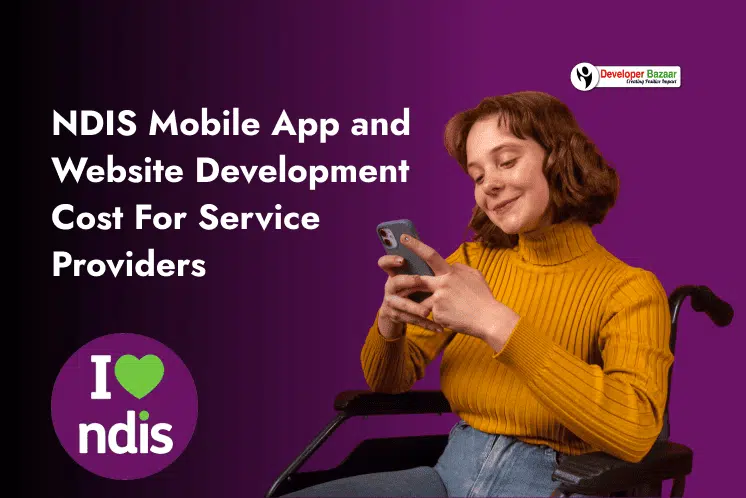Table of Contents
ToggleLearning a new language used to be difficult. But these days mobile applications make it possible to learn multiple languages with ease. Also, they have made it fun and games.
You can now learn a language anytime, anywhere, even if you only have 10 minutes a day. This guide will help you develop an AI based language learning app from scratch. We’ll explain what these apps do, why they’re so popular, and how they work. So, let’s begin.
What is a Language Learning App?
A language learning app is a smart tool that helps people learn new languages on their phones or computers. It uses games, fun exercises, and smart lessons to teach words, grammar, and pronunciation. These apps are different from old classroom methods. Just like traditional methods, you don’t need books or a teacher to learn, instead of this just open the app and start learning.
Some famous apps like Duolingo, Babbel, Busuu, and Memrise are already helping millions. They make learning feel like playing a game. If you want to build an AI language learning app like them, it’s important to learn from their features.
Why Are Language Learning Apps So Popular?
Language learning apps have become a huge discussion part all over the world, and it’s easy to understand why!
Because, they’ve changed the way people learn new languages by making it more fun, flexible, and affordable.
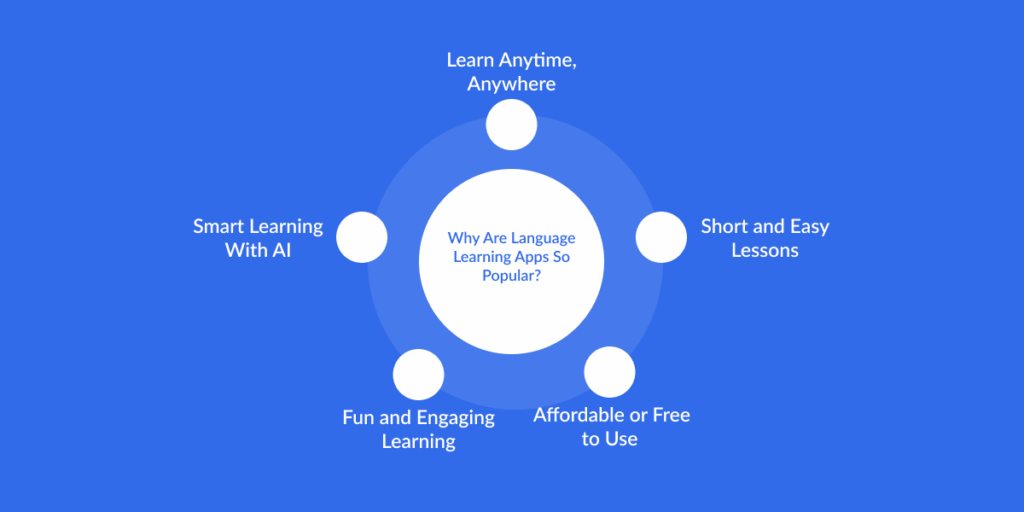
1. Learn Anytime, Anywhere
With language learning apps, you don’t have to attend a class or follow a fixed schedule. You can learn anytime you want, whether you’re at home, waiting for a bus, or on vacation. All you need is a phone and internet connection. This makes it perfect for busy people who want to learn on the go.
2. Short and Easy Lessons
Most apps use a method called microlearning, which means lessons are short and focus on one topic at a time. You only need 5 to 10 minutes a day to complete a lesson. This makes it easy for learners to stay consistent without feeling tired or overwhelmed. Even children can follow along without losing interest.
3. Affordable or Free to Use
One of the biggest reasons for their popularity is cost. Many top language apps like Duolingo offer free versions. Others like Babbel or Memrise offer paid plans, but they are still much cheaper than hiring a tutor or attending language schools. This makes learning a new language accessible to everyone, no matter their budget.
4. Fun and Engaging Learning
These apps don’t like regular study. They make the learning into a game, so much fun and grab the interest of the users. You can earn points, collect badges, level up, and even compete with friends. This is called gamification, and it keeps users motivated and excited to learn more. There are also fun quizzes, videos, and voice exercises that make learning interesting.
5. Smart Learning With AI
Modern language learning apps are getting smarter, thanks to AI development services. These apps track your progress, understand your strengths and weaknesses, and give you personalized lessons.
For example, if you keep forgetting certain words, the app will repeat them more often. This AI-based learning helps you improve faster and smarter.
In the past, learning a language meant reading big textbooks, attending classes, and doing boring homework. But now, with language learning apps, you can enjoy bright screens, colorful animations, helpful reminders, and even rewards for your progress.
These apps have made learning not only easier but also a lot more enjoyable for kids, adults, and everyone.
How do Language Learning Apps Work?
Language learning apps may look fun and colorful, but behind the scenes, they follow a smart and simple system to help you learn better.
Most of them follow these four main steps:
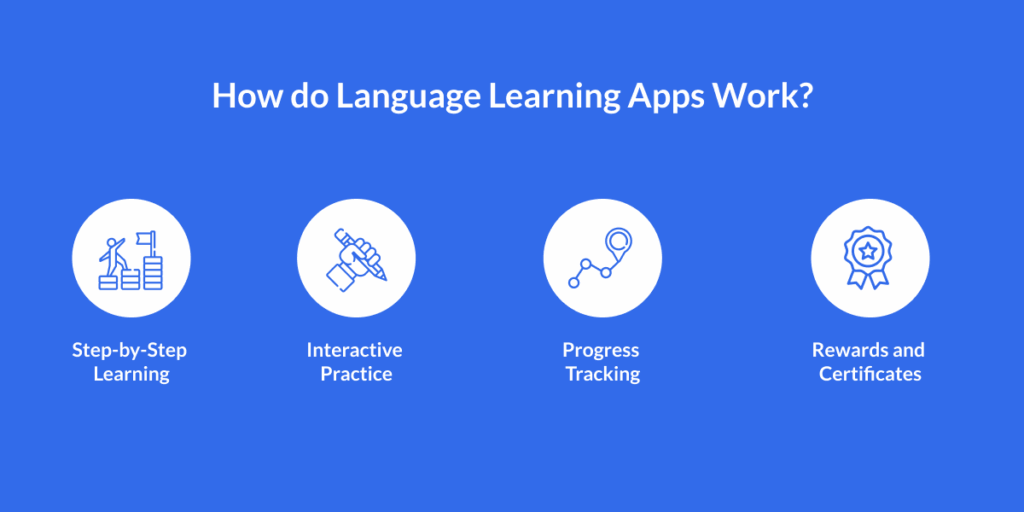
1. Step-by-Step Learning
The app teaches you in small parts, one step at a time. You don’t have to learn everything at once. Each lesson may focus on just a few things, like new words, basic grammar, or sentence structure.
For example, lessons may be grouped by topic such as:
- Food
- Travel
- Work
- Work
This makes it easy to learn useful words and sentences for real-life situations.
2. Interactive Practice
Just reading is not enough to learn a language. That’s why these apps use interactive methods to help you practice what you learn.
Some common practice tools include:
- Flashcards to remember new words
- Listening exercises to improve understanding
- Speaking tasks using voice features to check your pronunciation
- Mini-games that make learning fun and help you remember better
The goal is to make you use the language in different ways, not just read or write, but also speak and listen.
3. Progress Tracking
Language apps keep track of how much you’ve learned. This helps you stay motivated and see your growth.
Here’s how they show your progress:
- Progress bars to see how far you’ve come
- Daily streaks that reward you for learning every day
- Scores or stars for completing lessons or doing well on quizzes
This gives you a sense of achievement and encourages you to keep learning every day.
4. Rewards and Certificates
When you complete a course, finish a level, or hit a milestone, the app rewards you. You can earn:
- Badges
- Certificates
- Trophies
These rewards are fun to collect, and sometimes, certificates can even be useful for your job, school, or resume.
Special Features That Make Learning Easier
If you want to develop an AI based language learning app, here are some powerful features that make learning more effective and enjoyable:
1. Microlearning
Lessons are divided into small, quick parts. This helps people learn better without getting bored or tired. It also fits into a busy schedule, users can finish a lesson in just 5–10 minutes.
2. Gamification
Learning languages from apps like playing games. Users earn points, unlock levels, complete challenges, and collect rewards. This makes people excited to come back and keep learning every day.
3. Visual Progress
Seeing your progress helps you stay motivated. Whether it’s a bar showing how much of a course you’ve finished or badges for your achievements, it makes learning feel rewarding.
Language apps work by teaching small lessons, giving users lots of fun practice, tracking progress, and rewarding success. When combined with smart tools like AI, these apps can even offer personalized lessons based on what the user needs help with.
That’s why people love learning languages through apps, and why you should build one that’s just as smart and fun.
If you want to develop an AI language learning app, remember: keep it simple, fun, and smart. Use AI app development company expertise to add personal learning paths. Add games, rewards, and small lessons. That way, people of all ages, even a 5th grader can learn easily and enjoy the process.
Key Features You Must Add To Build an AI-Based Language Learning App
If you want to develop an AI based language learning app, adding the right features is very important. These features make your app helpful for learners and easy to manage for you or your team. Let’s divide them into two groups:
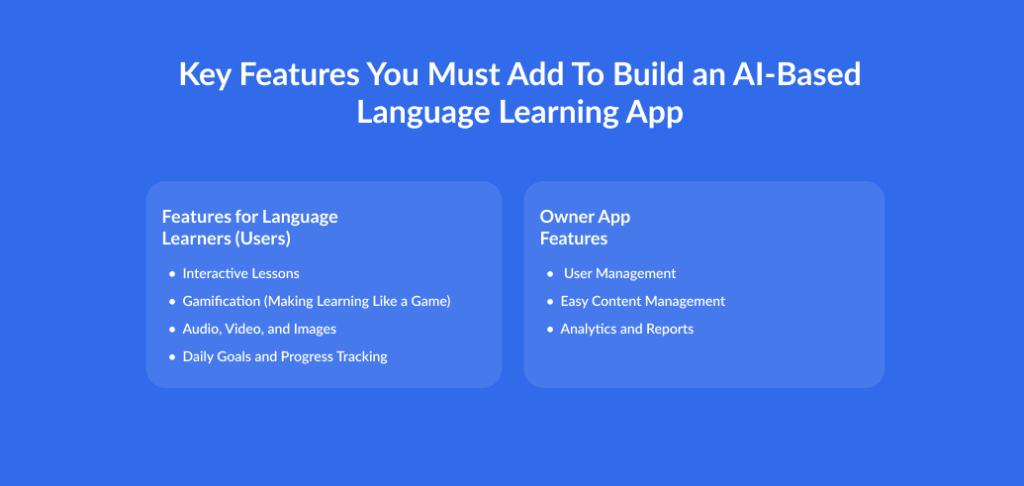
Features for Language Learners (Users)
These features make learning fun, easy, and effective:
1. Interactive Lessons
Your app should give lessons that match each learner’s level.
- If someone is a beginner, show them simple words, basic grammar, and slow-paced lessons.
- If they are advanced, give them harder sentences and conversation practice.
The app can use AI to understand what each user needs and adjust lessons to their speed and style. This makes learning easier and more enjoyable.
2. Gamification (Making Learning Like a Game)
People love games, and adding game-like features makes learning fun.
- Add points, badges, stars, or levels.
- For example, if a user finishes 10 lessons, they get a “Super Learner” badge.
This encourages users to come back daily and continue learning without getting bored.
3. Audio, Video, and Images
These tools make lessons more real and easier to understand:
- Audio helps users hear correct pronunciation.
- Videos show how people talk in real life and how the language is used in different situations.
- Images helps learners remember words better by connecting them to pictures.
Using these together helps learners understand and remember things more clearly.
4. Daily Goals and Progress Tracking
Let users choose small goals like:
✔ “Learn 10 new words today”
✔ “Practice for 5 minutes”
Also, show them a progress bar so they can see how much they’ve done. When users see progress, they feel happy and want to keep learning every day.
Features for Admins and App Owners
These features help you manage the app, update content, and track how users are learning.
1. User Management
You (or your team) can see how each learner is doing.
- You can help users who are stuck.
- You can also send messages, assign special goals, and see who needs support.
This helps users feel cared for and improves their learning experience.
2. Easy Content Management
Admins should be able to manage all lessons and content easily, even without a tech team. You should be able to:
- Add or edit lessons and quizzes
- Upload videos and pictures
- Delete or replace old or incorrect content
This keeps the app fresh, fun, and helpful for everyone.
3. Analytics and Reports
Your app should collect data to help you improve it. With reports, you can learn:
- How many people are using the app
- Which lessons are most liked
- Where users stop or lose interest
This helps you make better content and fix any issues quickly.
Bonus: Smart AI Features to Make Your App Stand Out
If you really want to create a powerful app, adding AI features is a must.
1. AI-Powered Personalized Lessons
AI can watch how a user learns, what they’re good at and where they struggle.
For example, if a user finds grammar hard, the app can give them more grammar practice. This way, each learner gets a custom path that fits their needs.
2. Instant Feedback with AI
When users do an exercise, AI can check their answers right away and explain their mistakes. They don’t have to wait for a teacher. This helps them fix errors and learn faster.
To build an AI language learning app, it’s best to work with an AI app development company that offers full AI development services. They can help you create a smart, smooth, and user-friendly app.
Top 5 AI Language Learning Apps in 2025
These apps are using AI in smart and fun ways to help users learn languages faster and better.
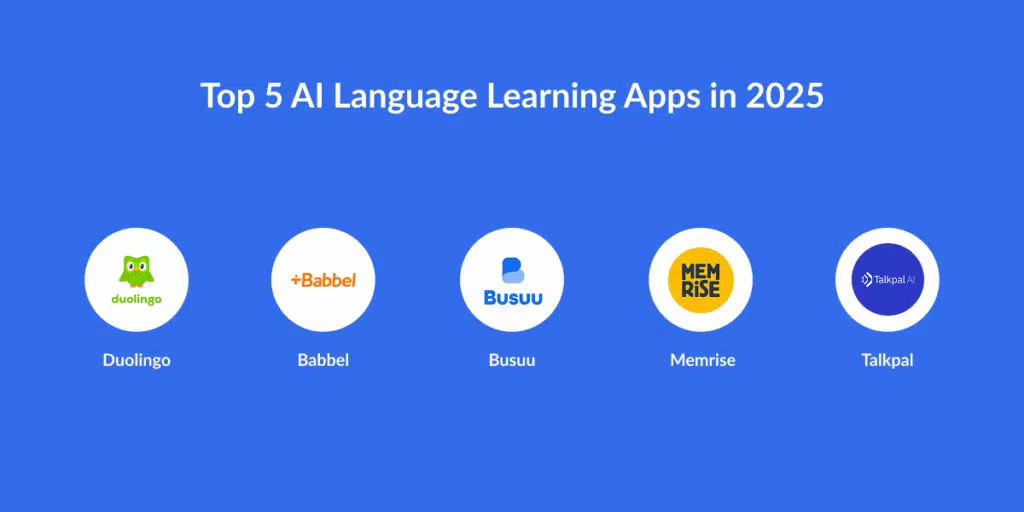
1. Duolingo
Duolingo is one of the most popular language apps in the world. It uses an AI system called BirdBrain to change the difficulty of lessons based on how you’re doing. If you’re doing well, the app gives you harder exercises. If you’re struggling, it gives you easier ones to help you catch up. This makes the learning feel just right for each user.
2. Babbel
Babbel helps you learn reading, writing, speaking, and listening skills. Its AI watches how you learn and gives you more help in areas you find difficult like grammar or vocabulary. It also offers videos, games, and podcasts to keep learning interesting. Babbel is great for people who want to improve their full language skills step-by-step.
3. Busuu
Busuu lets you practice with real native speakers through chats and short lessons. The app uses AI to track your learning style and offers smart reviews that focus on what you need to remember. It also shows you how many words you’ve learned and where you can improve. This helps you stay on track and learn faster.
4. Memrise
Memrise uses an AI trick called spaced repetition. It shows you the hard-to-remember words more often and the easy ones less often. This helps you move words from short-term memory to long-term memory. In just a few minutes a day, it helps you remember vocabulary much better over time.
5. Talkpal
Talkpal feels like you’re talking to a real person. It uses GPT technology to have natural conversations in over 55 languages. You can type or speak with the AI and get replies instantly. This is a great way to practice real conversations and improve your speaking confidence.
Major Steps of AI Language Learning App Development
Here are the easy-to-follow steps to develop an AI based language learning app with the help of experts:
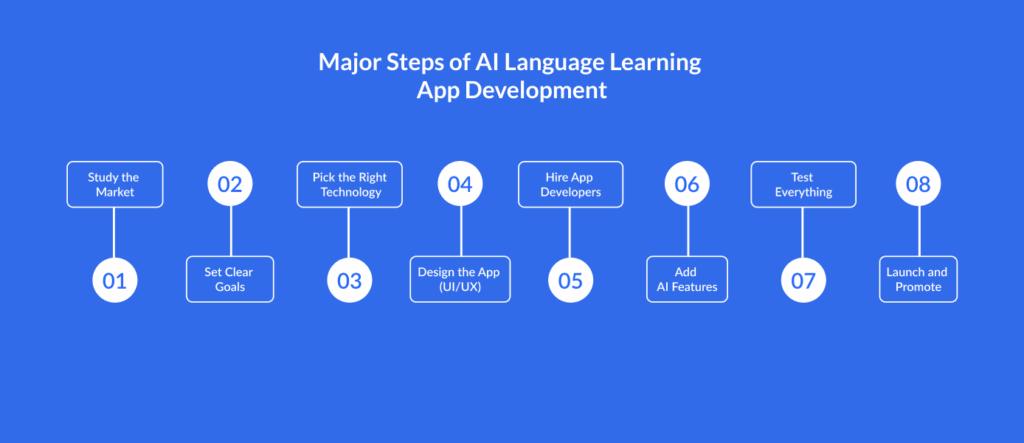
1. Study the Market
Start by learning what users want from a language app. Look at popular apps like Duolingo or Babbel, what do they do well? What features are missing?
Also, read user reviews to find common problems or requests. This helps you create an app that people will actually enjoy and need.
2. Set Clear Goals
Think about what your app will do and who it is for. Is your app for school kids, travelers, or people preparing for exams like IELTS?
Based on your goal, choose features like speaking practice, grammar exercises, daily challenges, or games. Setting a clear goal helps you stay focused and build the right features from the start.
3. Pick the Right Technology
Your app needs the right tools and software (called a tech stack) to work well. You’ll need to choose between Android, iOS, or both, and pick AI tools that can support features like speech recognition or progress tracking.
An experienced AI app development company can help you choose the best tools to build a fast, smart, and user-friendly app.
4. Design the App (UI/UX)
The design should be easy, clean, and fun to use. Use simple menus, large buttons, and bright visuals so users of any age can understand how to use it. Also, add helpful features like a progress bar, lesson suggestions, and daily goals to keep users motivated. Good design makes users want to come back every day.
5. Hire App Developers
If you’re not a developer, it’s best to hire experts AI app developers. A professional team or an AI development services provider can handle everything, from building the app to testing and launching it. They will also help add smart features, connect third-party tools, and make sure the app runs smoothly on all devices.
6. Add AI Features
AI is the brain behind your app. Here’s how you can use it:
- Speech Recognition: Understand what users say and correct their pronunciation.
- Smart Lessons: Adjust lesson difficulty based on the user’s performance.
- Reminders & Suggestions: Remind users to practice and suggest what to learn next.
These features make learning feel personal and help users improve faster.
7. Test Everything
Before you launch, test the app on different phones and tablets. Make sure all buttons work, lessons load properly, and AI features give correct feedback. Ask real users to try it and give honest feedback. Fix any bugs or problems so your app feels polished and ready.
8. Launch and Promote
Now it’s time to share your app with the world. Publish it on the Google Play Store, Apple App Store and other android Appstore alternatives. Then, promote it using social media, blogs, influencer reviews, or ads. Keep checking user feedback and update the app often to add new features or fix any issues.
How Much Does It Cost to Develop an AI-based Language Learning App?
If you want to develop an AI based language learning app, the cost depends on how simple or advanced your app is. Let’s break it down into two main types:
| Type of Language Learning App | Estimated Cost (Full App) |
|---|---|
| Static Mobile App | $20,000 |
| Dynamic Mobile App | $25,000 |
Static Mobile App
A static app has fixed content. It doesn’t change often. For example, if you only add a list of 100 English words and don’t update it, that’s a static app. It costs around $20,000 to build a simple app like this.
Dynamic Mobile App
A dynamic app can change content often. Admins can add new lessons, quizzes, and videos anytime without rebuilding the app. It also uses smart tools like AI to adjust lessons based on how users learn. This kind of app is more advanced and costs around $25,000 or more.
Development Cost Depends on Country
The cost to build an AI language learning app can also change based on where your developers live.
- In European countries, hourly rates are usually lower.
- In the USA, the rates are higher.But remember: high or low hourly price doesn’t always mean better or worse quality. What matters is choosing the right team.
Work with a trusted AI app development company that offers full AI development services. They can help you build smart features like speech recognition, grammar practice, and daily reminders.
Conclusion
Making an AI language learning app is a smart idea. These apps help people learn new languages faster using fun tools like games, voice feedback, and personal lessons. To build the best app, follow the right steps, from planning and designing to adding AI features. Even though it may cost very less, approximately $25,000+, the results are worth it. You can help people learn better while growing a useful business.
FAQs
1. How long does it take to build an AI language learning app?
A: Generally, It can take 3 to 6 months, rest will depend on the features and the app complexities. .
2. Can AI really help people learn faster?
A: Yes, AI gives users lessons based on their progress, helps with grammar mistakes, and reminds them to practice. This makes learning fun and effective.
3. Why should I hire an AI app development company?
A: They have the right tools and skills to add smart features like speech recognition, progress tracking, and live feedback. A good team will help you build a better app, faster.
4. Which is better: AI-based learning app or normal app?
A: AI-based apps are better because they understand the user’s progress and give smart suggestions. Normal apps don’t adjust lessons or give personal feedback.
5. How do AI apps help with speaking and listening practice?
A: AI listens to how you speak, checks your pronunciation, and gives instant tips to improve. It also plays audio clips so you can practice listening skills.
6. Can I earn money from my AI language learning app?
A: Yes, You can earn through ads, paid subscriptions, premium courses, or one-time purchases. Many apps offer a free version with paid upgrades.

RM Mishra
Co-Founder
Developer Bazaar technologies










